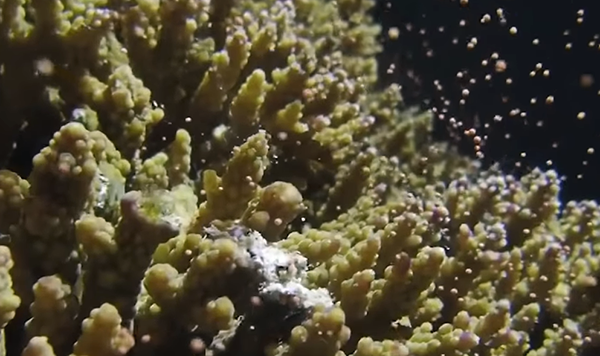A new reef robot is spreading coral babies on the Great Barrier Reef. And why should Gold Coasters take note? This “coral IVF” technology could be used off our own shores. The artificial reefs planned for the Gold Coast will start construction very soon.
A reef-building robot recently acted as a ‘mother’ to hundreds of millions of baby corals in a special delivery event. The ‘baby delivery’ was timed to coincide with the annual coral spawning on the Great Barrier Reef. The underwater robot – LarvalBot – was made by QUT’s robotics team, led by Professor Matthew Dunbabin.

The LarvalBot
Robot Spawner
Scientists began the project by collecting hundreds of millions of coral spawn. But this was only from coral that has survived the two recent bleaching events. That is, larva that are heat-tolerant. This is because many scientists think heat can be blamed for the 2016 coral deaths on the Great Barrier Reef. The collected spawn are left to grow into baby corals in large floating enclosures on the reef. Once developed (in around 5–7 days), the semi-autonomous robot is loaded up with the baby corals. It then spurts them onto target reefs.

LarvalBot has the advantage of speed. It has been shooting out ‘larval clouds’ on damaged reefs on a larger scale than any other method ever before.
Robot Squirting
Professor Dunbabin is working with Southern Cross University’s Professor Peter Harrison. Harrison is a pioneer of the coral larval restoration technique. “We concentrate the larvae and put some of these into LarvalBot to gently squirt the larvae onto dead reef areas allowing it to settle. The surviving corals will start to grow and bud and form new colonies. These will grow large enough after about three years to become sexually reproductive and complete the life cycle.”

Divers helping the baby coral to grow.
The spectacular synchronised spawning of coral reproduction on the Great Barrier Reef is a highlight on scientists’ calendars worldwide. It takes place in late November. The researchers say by giving nature a helping hand through artificial means, it allows a 100-times increase over previous methods. Delivering baby corals is another win for underwater robots. This same pioneering technology was also used to control the crown-of-thorns starfish. With two artificial reefs planned for the Gold Coast, the potential to use these robots to build underwater sanctuaries on the Gold Coast is exciting.

Divers looking after the baby coral
Said Professor Harrison, “With further research and refinement, this technique has enormous potential to operate across large areas of reef and multiple sites in a way that hasn’t previously been possible. We’ll be closely monitoring the progress of settled baby corals over coming months and working to refine both the technology and the technique to scale up further into 2019.”
Hiri Corals
A company that can help to build reefs on the Gold Coast is Hiri Corals. They aim to restore coral reefs around the world. Says Co-Founder Debora Kocak, “We would love to be a part of the Gold Coast reef building projects. Currently, we would need the green light from the Gold Coast council to potentially plant on the artificial reef.”

Rebuilding reefs in Papua New Guinea
Hiri is a profit-for-purpose company. The mission is to bring coral conservation to as many people as possible. Says Kocak, “Our main focus is on running training programs in rural coastal areas in the Pacific, and around Australia, about the importance of coral to the actual planting of it. We run groups through each process in an easy-to-understand program. By the end of it, they are easily able to tackle their own conservation projects. Another benefit to our training is that we help them find ways to re-use materials that may be lying around the village or coastal area – PVC pipes, old fishing lines, metal rods. These can be made into frames onto which coral fragments are attached. So we help a little with recycling – however, we are quite picky about which materials we allow them to use so that we don’t damage the ocean.

Upcycling materials to use as a reef foundation
Local Projects
“So far, we have received opportunities abroad to restore coral and to work with communities in developing countries. However, we have yet to complete a project locally!”
Gold Coast residents can get involved in a unique coral experience through Hiri. “We work with local dive shops, surf camps, resorts and more to offer half and full day excursions. You can learn all about the importance of coral, the planting process, build eco-friendly frames, and contribute to the cause.”

Implanting the reef babies back into the ocean.
Reef Value
As a foundation species of the ocean, coral provide habitats and shelter for many marine organisms. Coral combat climate change by assisting in carbon and nitrogen fixing. Over half a billion people depend on coral for food, income and protection. The net economic value of the world’s coral reefs is estimated to be 300+ billions of dollars a year. For example, the Great Barrier Reef generates more than 1.5 billion dollars every year for the Australian economy. Also, reefs are beautiful. They provide spectacular diving and snorkelling spots that allow you enter the colourful world of the sea. There are over 2,500 types of coral hosting millions of species of marine life. In conclusion, reefs are known as “rainforests of the sea,” and cover less than 1% of the ocean. But they are home to almost 25% of all known marine species.

Editor for Silver Magazine Gold Coast

